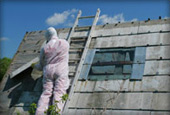Homeowners love do-it-yourself (DIY) projects not only for the financial savings, but also for the sense of accomplishment that comes with a self-done renovation. These advantages, however, can be countered by several risks – including the risk of asbestos exposure.
Although most products made today do not contain asbestos, remodeling or renovating a home built before the 1980s – when asbestos was extremely common in the construction industry – can pose a significant asbestos exposure risk if done incorrectly.
Professional asbestos abatement is always recommended over personal attempts at asbestos management, but there are certain precautions handymen can take if considering a DIY renovation.
What Home Materials Contain Asbestos?
In the past, asbestos was used in hundreds of different industrial materials because it was an inexpensive and durable insulator. Some products, such as asbestos-containing textured paint, patching compounds and ceiling joints were banned in 1977. Other products were not directly outlawed, but they were subject to regulations. These products are present in nearly any home built before the 1980s, and they can include:
- Pipes
- Boilers
- Tiles
- Shingles
- Gaskets
- Fibreboard
- Vermiculite insulation
Almost every home constructed during the peak of asbestos use in the United States is presumed to contain these products.
How to Keep Yourself and Your Family Safe During Renovations
Asbestos that is simply present in a house is not a health danger. Only when the asbestos is disturbed does it become a risk. Asbestos that is contained within a construction product can be disturbed though a number of ways:
- Tearing up asbestos shingles
- Scraping up asbestos adhesives
- Chipping away at asbestos paint
- Sawing through asbestos siding
- Repairing parts on boilers, pipes and ducts
- Drilling through asbestos soundproofing
Before completing any handyman tasks that could potentially release asbestos fibers into the air, you should consult with a licensed asbestos abatement company. The company can test potentially asbestos-containing products to evaluate any health risks.
Attempting asbestos abatement as an untrained homeowner can be extremely dangerous. If damaged asbestos is found, the asbestos abatement professionals should encapsulate or remove it before you complete any additional work.
Author bio: Faith Franz is a writer for the Mesothelioma Center. She combines her interests in whole-body health and medical research to educate the mesothelioma community about the newest developments in cancer care.

